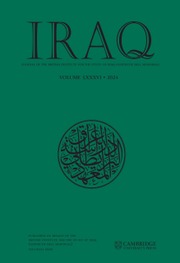No CrossRef data available.
Article contents
OF CAPTIVE STORM GODS AND CUNNING FOXES: NEW INSIGHTS INTO EARLY SUMERIAN MYTHOLOGY, WITH AN EDITION OF NI 12501
Published online by Cambridge University Press: 24 February 2025
Abstract
This paper publishes the editio princeps of an Early Dynastic IIIb tablet from Nippur, which contains a unique yet fragmentary Sumerian narrative about the storm god Iškur’s captivity in the netherworld, from which he appears to be rescued by Fox. While the incomplete state of preservation prevents a reconstruction of the plot, individual motifs can be traced across the entire cuneiform corpus, allowing for a preliminary case study of continuity and change over more than two millennia of Mesopotamian mythological literature.
عن آلهة العواصف الأسيرة والثعالب الماكرة: رؤى جديدة ف& ي الأساطير السومرية المبكرة، مع طبعة ني Ni 12501
بقلم: يانا ماتوزاك
تنشر هذه الورقة نسخة من الطبعة الأولى من لوح من طبعة ED IIIb من نيبور، والذي يحتوي على رواية سومرية فريدة من نوعها ولكنها مجزأة عن أسر إله العاصفة إيشكور في العالم السفلي، والذي يبدو أنه تم إنقاذه منه على يد ثعلب. وفي حين أن عدم اكتمال حالة الحفظ يحول دون سرد القصة بشكل صحيح،ولكن يمكن تتبع الزخارف الفردية عبر مجموعة النصوص المسمارية بأكملها، مما يسمح بإجراء دراسة حال أولية للاستمرارية والتغيير على مدى أكثر من ألفي عام من الأدب الأسطوري في بلاد ما بين النهرين.
- Type
- Research Article
- Information
- Copyright
- © The British Institute for the Study of Iraq 2025


